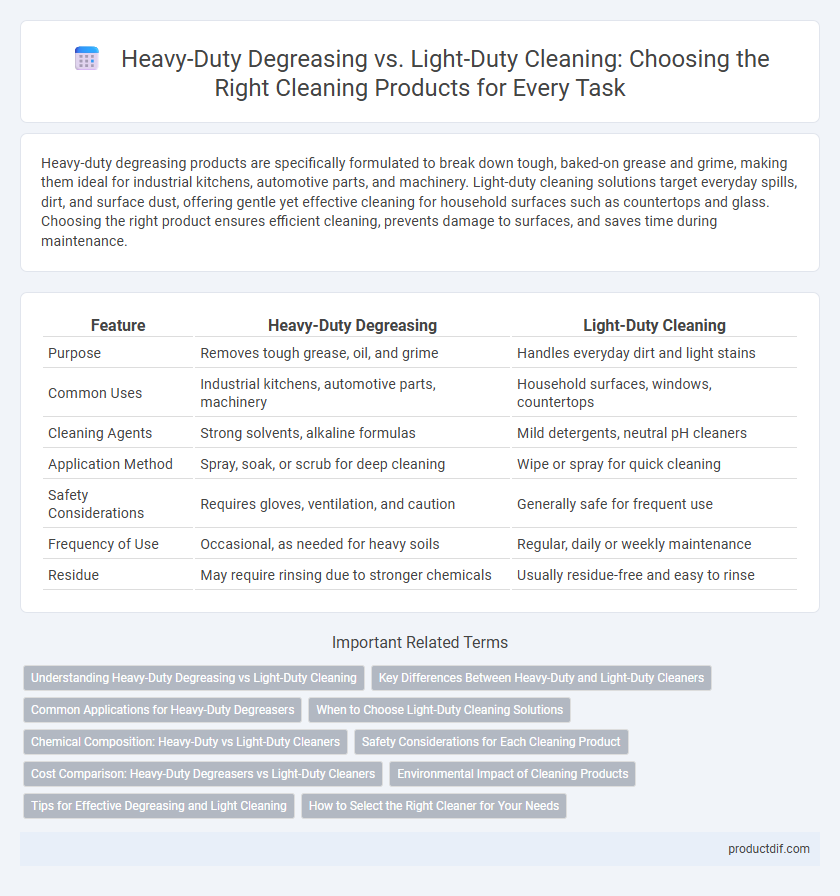Heavy-duty degreasing products are specifically formulated to break down tough, baked-on grease and grime, making them ideal for industrial kitchens, automotive parts, and machinery. Light-duty cleaning solutions target everyday spills, dirt, and surface dust, offering gentle yet effective cleaning for household surfaces such as countertops and glass. Choosing the right product ensures efficient cleaning, prevents damage to surfaces, and saves time during maintenance.
Table of Comparison
| Feature | Heavy-Duty Degreasing | Light-Duty Cleaning |
|---|---|---|
| Purpose | Removes tough grease, oil, and grime | Handles everyday dirt and light stains |
| Common Uses | Industrial kitchens, automotive parts, machinery | Household surfaces, windows, countertops |
| Cleaning Agents | Strong solvents, alkaline formulas | Mild detergents, neutral pH cleaners |
| Application Method | Spray, soak, or scrub for deep cleaning | Wipe or spray for quick cleaning |
| Safety Considerations | Requires gloves, ventilation, and caution | Generally safe for frequent use |
| Frequency of Use | Occasional, as needed for heavy soils | Regular, daily or weekly maintenance |
| Residue | May require rinsing due to stronger chemicals | Usually residue-free and easy to rinse |
Understanding Heavy-Duty Degreasing vs Light-Duty Cleaning
Heavy-duty degreasing targets stubborn grease, oils, and baked-on residues commonly found in industrial kitchens and automotive workshops, employing strong solvents and surfactants for deep cleaning. Light-duty cleaning effectively removes everyday dirt, dust, and mild stains from surfaces using milder ingredients, suitable for regular household upkeep and delicate materials. Selecting the appropriate cleaning product depends on the surface type and soil severity to ensure optimal performance and maintain surface integrity.
Key Differences Between Heavy-Duty and Light-Duty Cleaners
Heavy-duty degreasing products contain stronger solvents and surfactants designed to break down stubborn grease, oil, and industrial contaminants, making them ideal for kitchens, machinery, and automotive parts. Light-duty cleaners generally feature milder ingredients suitable for routine maintenance on delicate surfaces such as glass, countertops, and painted walls without causing damage. The primary differences lie in their chemical composition, application areas, and cleaning power, with heavy-duty formulas focusing on intensive grime removal and light-duty products emphasizing gentle, everyday cleaning.
Common Applications for Heavy-Duty Degreasers
Heavy-duty degreasers are specially formulated for industrial and commercial environments where removing stubborn grease, oil, and grime is essential. Common applications include automotive repair shops, manufacturing plants, kitchens, and heavy machinery maintenance, where standard light-duty cleaners fail to break down tough residues. These powerful degreasers enhance operational efficiency and maintain equipment longevity by ensuring thorough cleansing of heavily soiled surfaces.
When to Choose Light-Duty Cleaning Solutions
Light-duty cleaning solutions are ideal for routine maintenance tasks involving light grease, dirt, and surface dust, especially on delicate materials like glass and painted surfaces. They offer effective removal of mild contaminants without damaging finishes or leaving harsh residues. Choose light-duty cleaners for frequent use in kitchens, bathrooms, and office environments where gentle but efficient cleansing is required.
Chemical Composition: Heavy-Duty vs Light-Duty Cleaners
Heavy-duty degreasing products contain stronger chemicals such as caustic agents, solvents, and alkaline compounds designed to break down stubborn grease, oil, and grime on industrial surfaces. Light-duty cleaners typically use milder ingredients like surfactants, detergents, and biodegradable agents suitable for everyday dirt and light staining on household materials. The chemical composition of heavy-duty cleaners delivers aggressive cleaning power, while light-duty formulas prioritize safety and environmental compatibility.
Safety Considerations for Each Cleaning Product
Heavy-duty degreasing products often contain potent chemicals like solvents and caustics that require careful handling to prevent skin irritation, respiratory issues, and environmental harm. Light-duty cleaning agents typically use milder surfactants and safer ingredients, making them suitable for regular household use with minimal safety precautions. Proper personal protective equipment (PPE) such as gloves and adequate ventilation are essential when using heavy-duty degreasers to ensure user safety.
Cost Comparison: Heavy-Duty Degreasers vs Light-Duty Cleaners
Heavy-duty degreasers typically cost more upfront than light-duty cleaners due to their stronger chemical formulations and specialized ingredients designed to break down stubborn grease and oils effectively. Light-duty cleaners are generally more affordable and suitable for routine cleaning tasks but may require frequent application or additional products to maintain cleanliness in industrial settings, potentially increasing overall expenses. Evaluating the total cost of ownership involves considering product price, application frequency, and required cleaning intensity to determine the most cost-efficient choice.
Environmental Impact of Cleaning Products
Heavy-duty degreasers typically contain strong chemicals that effectively break down stubborn grease but can pose significant environmental risks due to toxicity and slow biodegradability. In contrast, light-duty cleaners often utilize biodegradable ingredients with lower toxicity, resulting in reduced harm to aquatic ecosystems and better overall environmental compatibility. Choosing products with eco-friendly certifications and minimal volatile organic compounds (VOCs) helps mitigate pollution and supports sustainable cleaning practices.
Tips for Effective Degreasing and Light Cleaning
Heavy-duty degreasing requires using specialized solvents or alkaline cleaners that break down tough grease and oil residues on industrial surfaces, ensuring deep cleaning effectiveness. For light-duty cleaning, mild detergents or all-purpose cleaners suffice to remove everyday dirt and grime without damaging delicate surfaces. To maximize results, apply degreasers with appropriate dwell time on surfaces, use proper agitation techniques, and rinse thoroughly, while light cleaning benefits from gentle scrubbing and regular maintenance to prevent buildup.
How to Select the Right Cleaner for Your Needs
Selecting the right cleaner depends on the level of soil and surface type; heavy-duty degreasers contain powerful solvents targeting tough grease, oils, and industrial grime, ideal for engines, machinery, and commercial kitchens. Light-duty cleaners are formulated with milder surfactants suitable for everyday dirt, dust, and light stains on delicate surfaces like glass, countertops, and painted walls. Assessing the cleaning challenge and material compatibility ensures effective removal of contaminants without damaging the surface.
Heavy-duty degreasing vs Light-duty cleaning Infographic

 productdif.com
productdif.com